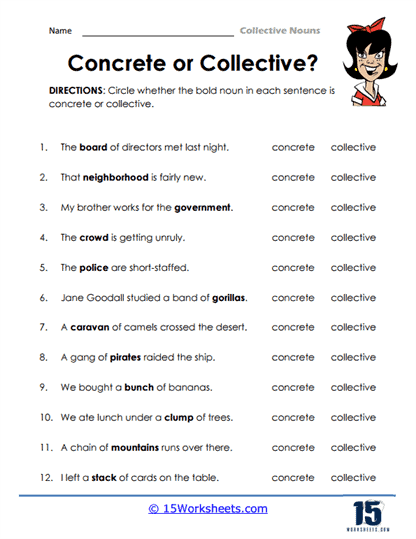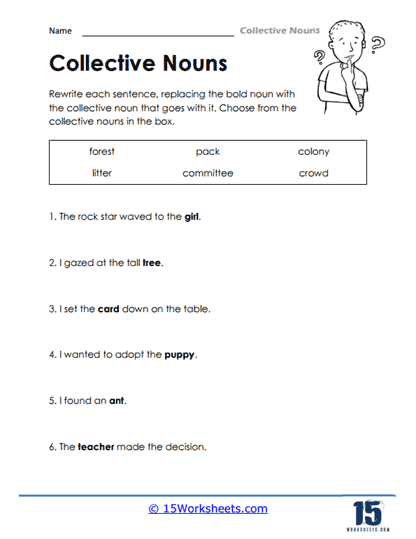Collective Nouns Worksheets
All About These 15 Worksheets
These collective nouns worksheets are designed to help students understand the concept and usage of collective nouns in English grammar. Collective nouns are singular nouns that refer to a group of individuals or things, such as “family,” “team,” or “herd.”
Some of these worksheets, as appropriate, begin with an introduction to the definition and functions of collective nouns, including examples of common collective nouns and their usage. This guides students in identifying them in sentences.
The worksheets may include exercises where students have to identify the collective nouns in sentences, and distinguish them from plural nouns. By accomplishing these worksheets, students will:
- Identify the collective nouns in sentences;
- Have a mastery of collective nouns for animals and other things;
- Distinguish collective nouns from plural nouns;
- And determine whether a noun is concrete, abstract, or collective.
Overall, these worksheets provide students with a clear understanding of what collective nouns are, how to identify them in sentences, and how to use them correctly to enhance their writing.
What are Collective Nouns?
Collective nouns are nouns that refer to a group of people, animals, objects, or things as a single unit. They are singular in form, but they represent a collection of individuals or objects.
Examples of collective nouns include “team,” “herd,” “family,” “group,” “crowd,” “audience,” and “committee.” These nouns are used to describe a group of people or things, rather than individual members of the group.
Collective nouns are often followed by a singular verb, even though they refer to a group of individuals. For example, “The herd is grazing in the field” is correct, while “The herd are grazing in the field” is incorrect.
Some collective nouns are countable and can take plural forms, such as “team” (teams), “family” (families), and “committee” (committees). However, they still refer to a group of individuals or objects as a single unit.
What are Abstract and Concrete Nouns?
In English grammar, nouns can be classified into three types: concrete, abstract, and collective. Here’s how to distinguish collective nouns from concrete and abstract nouns:
- Concrete nouns refer to things that can be seen, touched, heard, tasted, or smelled. Examples include “dog,” “book,” “apple,” “music,” and “perfume.” Concrete nouns are often identified by their ability to be perceived by the five senses.
- Abstract nouns refer to things that cannot be perceived by the senses, such as ideas, concepts, emotions, and qualities. Examples include “love,” “happiness,” “justice,” “freedom,” and “loyalty.” Abstract nouns are often identified by their intangible nature and inability to be perceived by the senses.
To determine the type of noun, it’s important to consider the meaning and context of the word. Ask yourself whether the noun refers to a tangible or intangible object, or whether it refers to a group of individuals or objects. Reading the sentence or phrase in which the noun appears can also provide context and help identify the type of noun.















